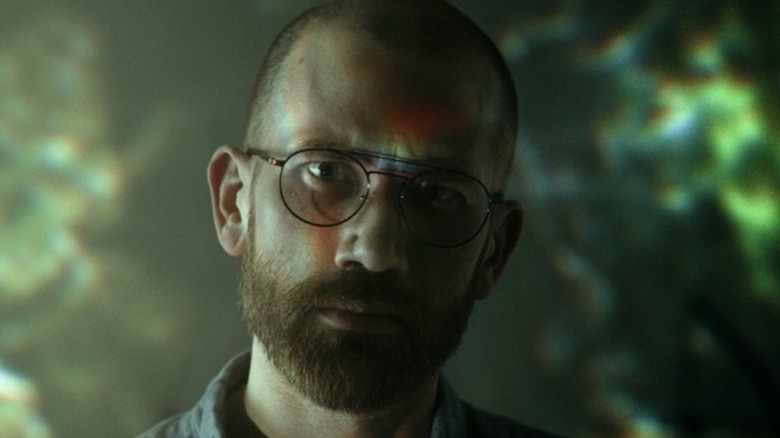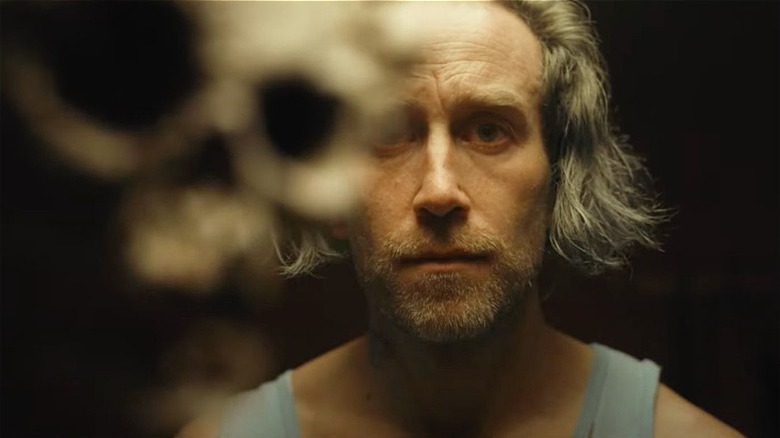How Benson And Moorhead Used Lies To Create The Characters Of Something In The Dirt
Directing duo Justin Benson and Aaron Moorhead have created a string of films that are terrifying snapshots of unsettling phenomena affecting idiosyncratic characters. A typical Benson and Moorhead joint features the duo as central characters, who are usually faced with increasingly baffling circumstances that are often interconnected. For instance, their "Endless" and "Resolution" appear to share the same world, one in which time loops generate cyclical trauma and characters are at the mercy of an entity that demands appeasement. In their latest sci-fi comedy "Something in the Dirt," Benson and Moorhead evoke an apocalyptic world seemingly inhabited by two men who happen to be neighbors in Laurel Canyon. As stranger things transpire and the doom intensifies, the dynamic between the two men becomes increasingly tense, deepening the web of inexplicable terror.
As "Something in the Dirt" takes place entirely inside the low-rent apartment inhabited by Levi (Benson) and John (Moorhead), the narrative is solely driven by the conversations between the two characters. Both of them seem to be fighting their own demons while fabricating half-truths for the other to consume, making their exchange throughout the film seem extremely dubious. There are glimmers of the truth from time to time, but not enough to alleviate the escalating terrors that grip their immediate surroundings.
Benson and Moorhead accomplished this by incorporating shades of lies that the characters use to justify their actions and convince themselves of their innocence. This is a delicate balancing act, as these lies ultimately allow audiences to slowly arrive at the truth that lies at the heart of the film. Here's how the directing-writing-acting duo pulled this off in their latest, mind-boggling offering.
Lies shield us from confronting our true selves
In an interview with The New York Times, Benson and Moorhead talked at length about injecting the personal into the fictional, and the film's anomalous, fragmented storyline allowed them to etch deeply flawed human characters. Lies are an essential part of human existence, often woven into our version of events and how we perceive ourselves. There are half-truths that we often tell others (and ourselves) to keep certain realizations and harsh truths at bay, and this essence was captured in the characters of John and Levi. Benson explained:
"They lie in different ways. Levi works at a bar and wants to put his best foot forward. He's probably got half a dozen different stories, and once you run out of them, you end up with this sad, lonely soul. John lies for other reasons, but the way they lie was part of fleshing them out as real human beings."
"Something in the Dirt" is an intensely paranoid film — it is a story intended to conjure suspicion, and the eerie, meandering exchange between John and Levi intensifies this feeling of anxiety. Although the lies uttered by the characters sustain this sense of paranoia, Moorhead explains that these fabrications do not necessarily make them villainous. By the end, it is revealed that neither of them is good or evil in the standard sense of the term, but "flawed human beings, neither villain nor hero." For instance, Levi has a murky criminal past and is painfully aware of his shortcomings, but needs to believe in his lies in order to wake up every day and look himself in the eye. People like Levi can only hope to be virtuous, irrespective of whether they truly are or not.
The truth remains ever-elusive
The way in which Levi and John lie to one another gradually reveals layers of the truth, the discovery of which has disastrous consequences. As the two men converse, wacky stuff starts happening: quartz crystal objects emit light and begin levitating, a carnivorous plant births a disgusting-looking fruit, and a collection of weird noises are heard in the night. Deciding to work together to unravel the truth of the matter, John and Levi document these events in real-time and fall down a dangerous rabbit hole of conspiracy theories, wild speculations, pseudo-scientific beliefs, and forced patterns.
While these horrors are certainly worth discovering, what binds this bizarre experience together is the electrifying, collaborative dynamic shared by the central duo. The two men are engrossed in a world inhabited only by them, removed from their immediate reality while being privy to some otherworldly phenomena. On some level, this dynamic mirrors that of the real-world duo, although the characters are "wildly different" from who they are. The appeal of being able to write stories that passionately reflect one's interests is the freedom that comes with it, allowing creators like Benson and Moorhead to explore what makes us intrinsically human — especially in a volatile, apocalyptic setting.
The true horror of "Something in the Dirt" is not the lies that John and Levi tell each other to evade self-introspection or judgment by fellow man. It is, in fact, the unexplained nature of the truth which leaves us with plenty to ponder, particularly when it involves questions about morality and what it means in a cold, indifferent universe. For John and Levi, whose lies have layers like a matryoshka doll, the truth remains indefinite and elusive. All is not well in the end.


